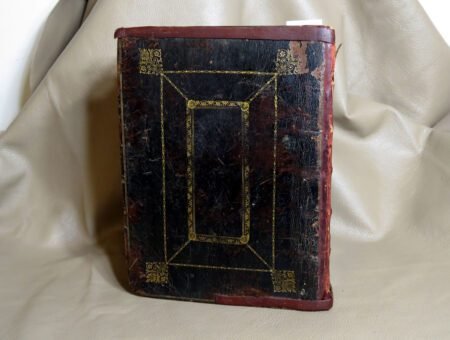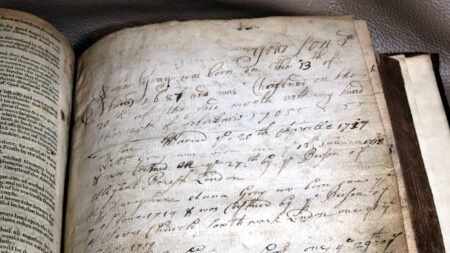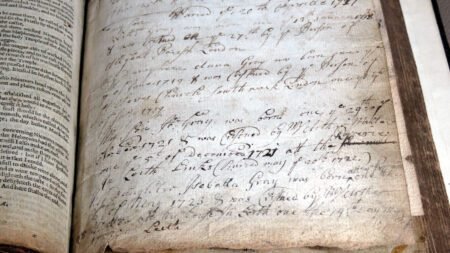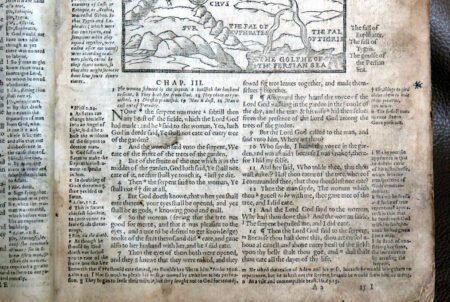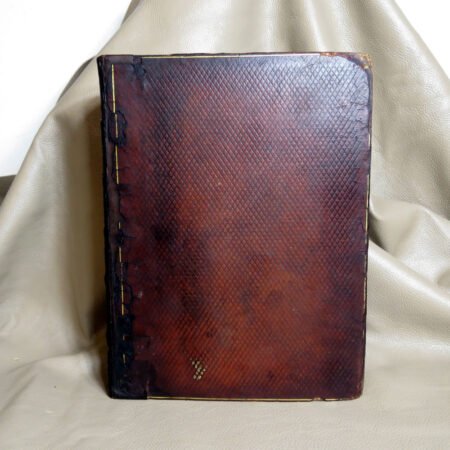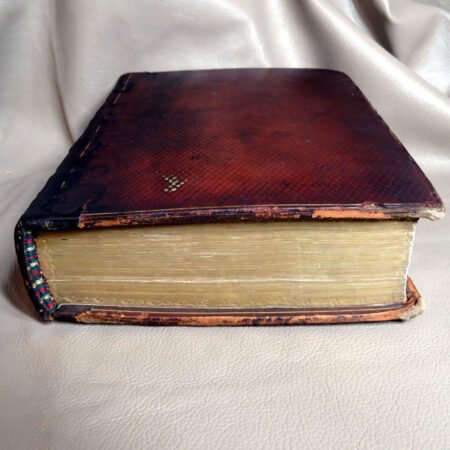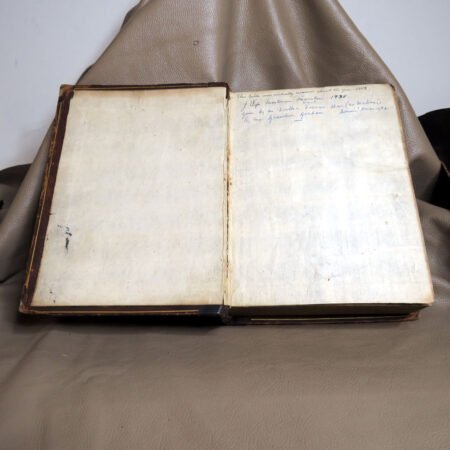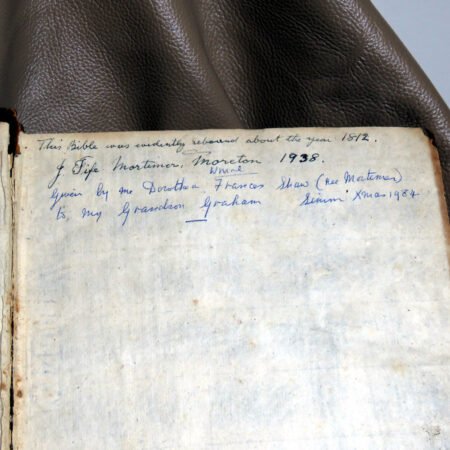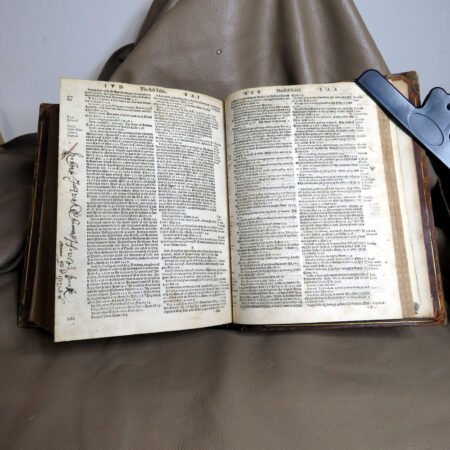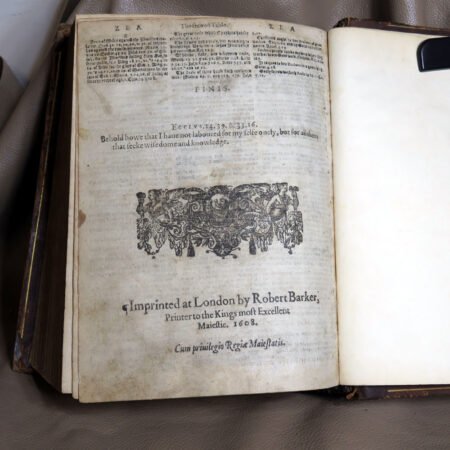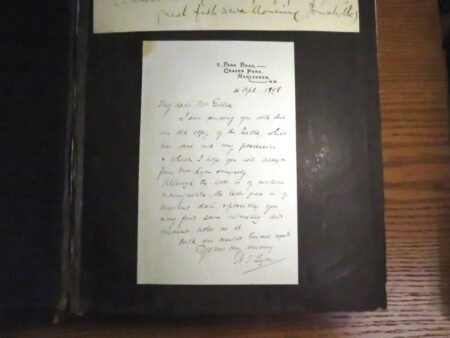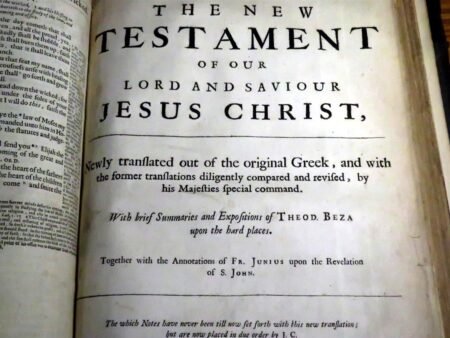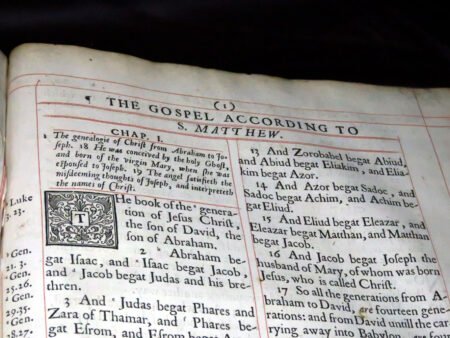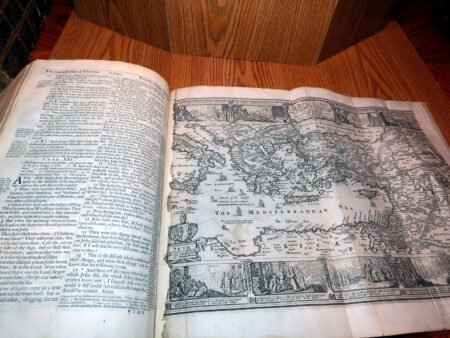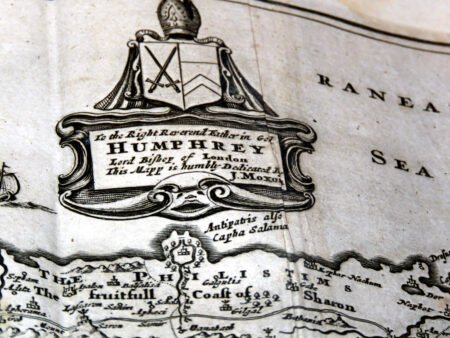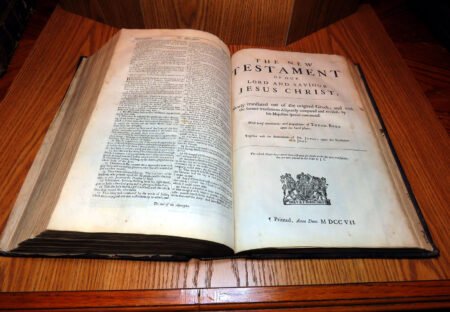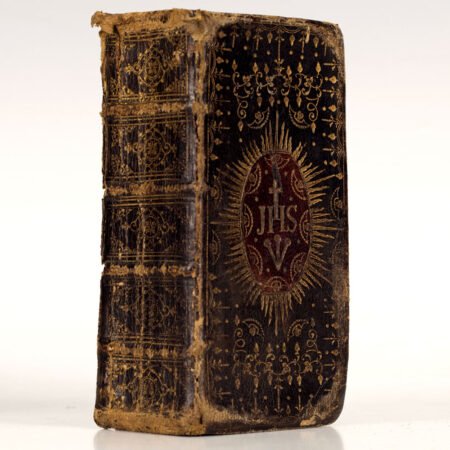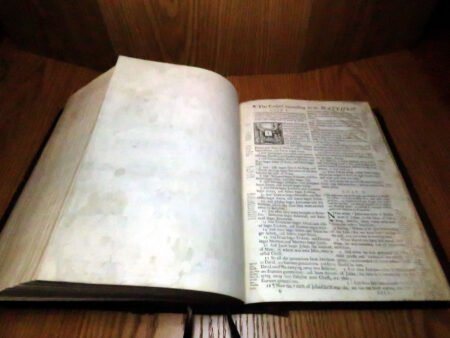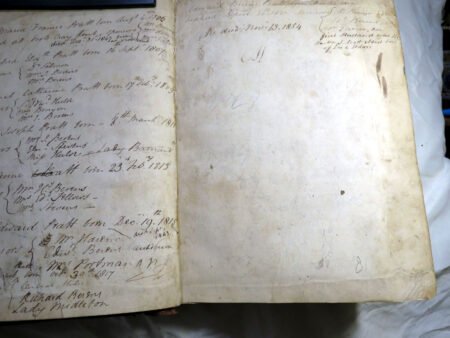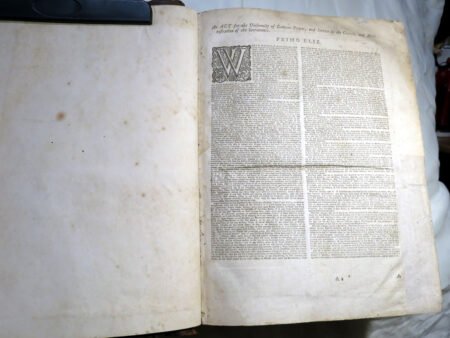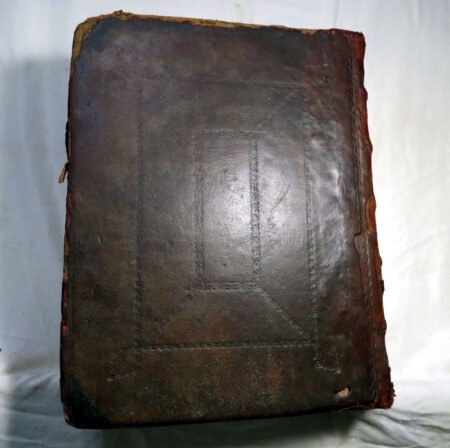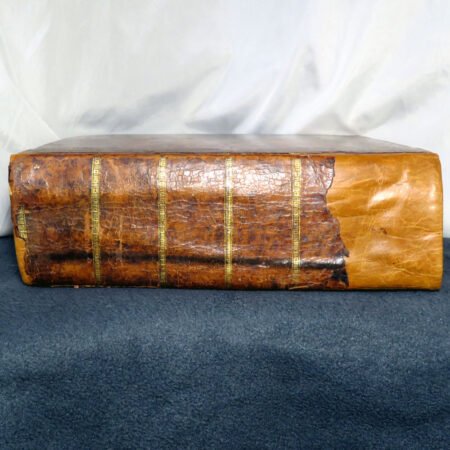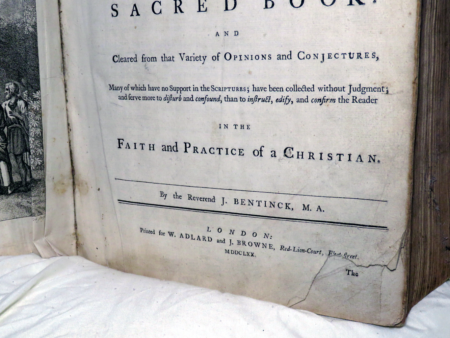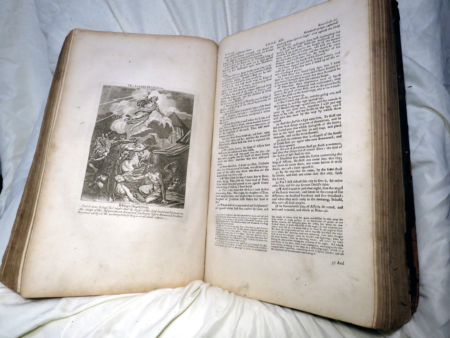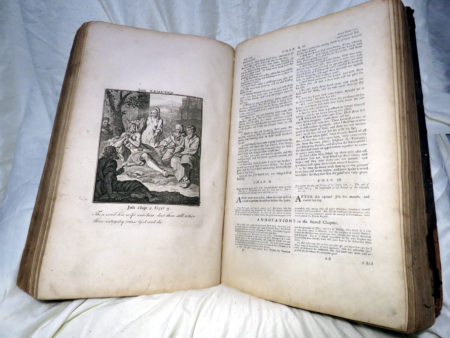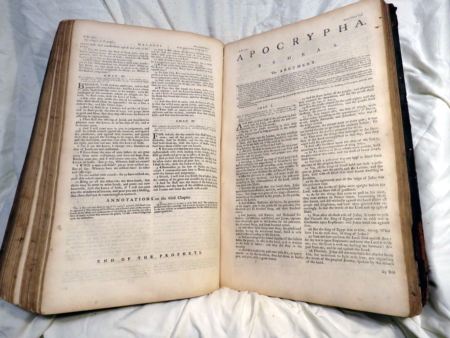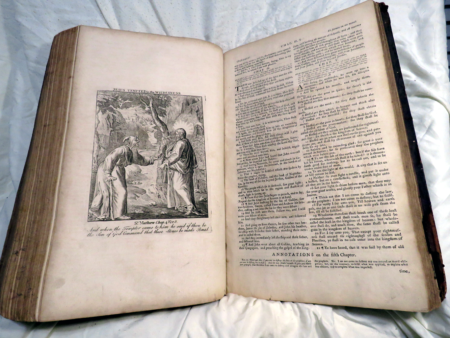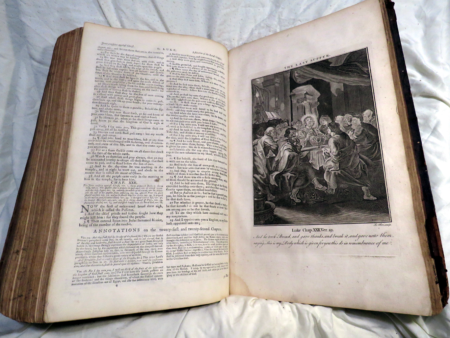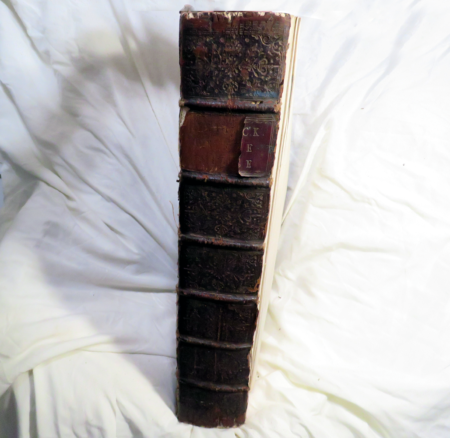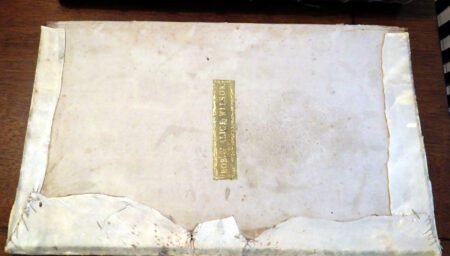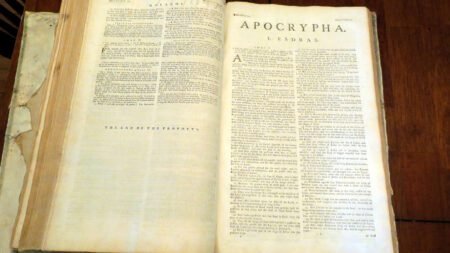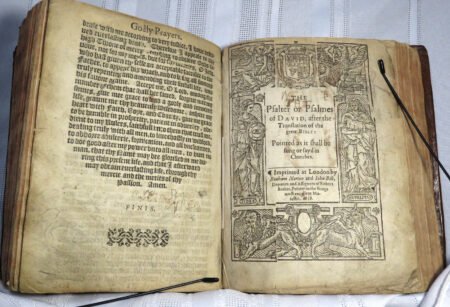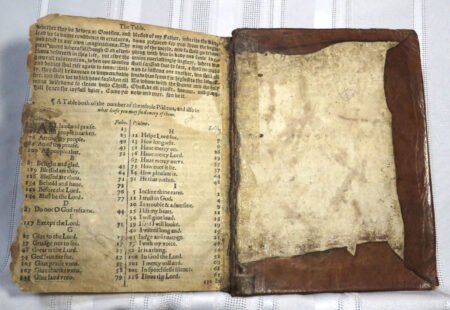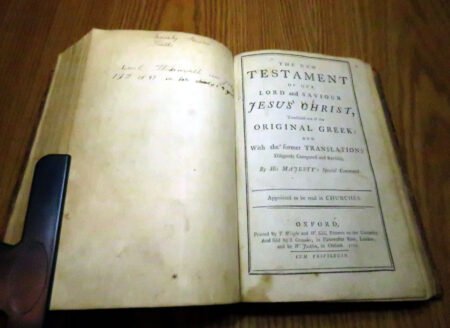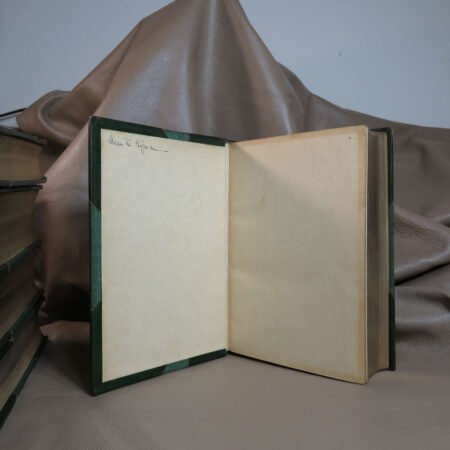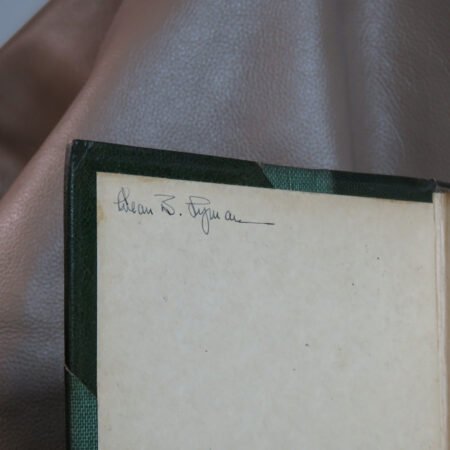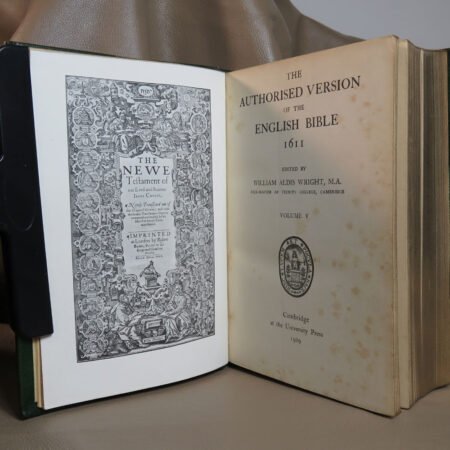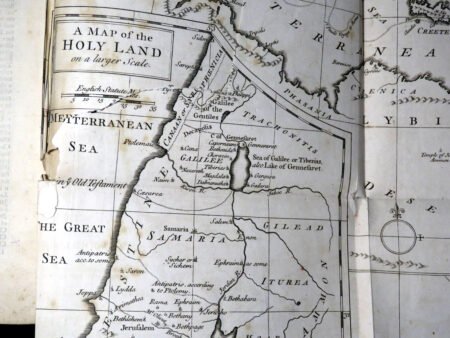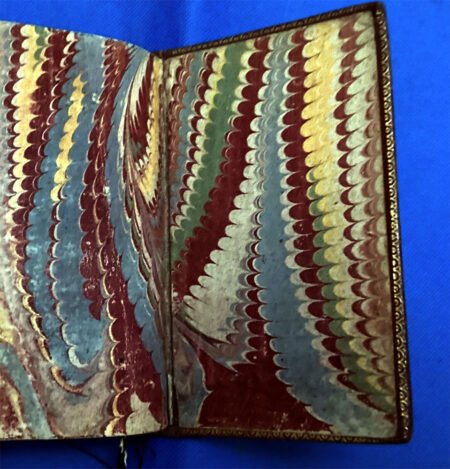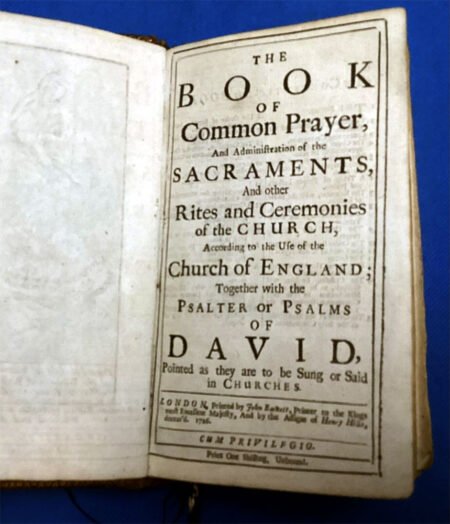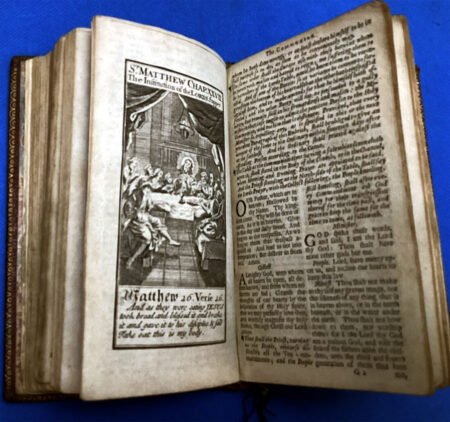English
Showing 1–24 of 35 resultsSorted by price: high to low
-

1595 Geneva Breeches Bible printed by Christopher Barker, Theo. Beza
$2,999.99 Quick ViewAdd to cart Buy Now Wishlist1595 Geneva Breeches Bible printed by Christopher Barker, Theo. Beza
$2,999.99
This 1595 Geneva Bible, printed by the deputies of Christopher Barker, is a quarto edition of the Geneva Bible, an important and influential version of the scriptures for late 16th-century Protestants. This 1595 version is a significant historical artifact that provides insight into the era’s religious, cultural, and publishing landscape.
See the description below for more info:
1 in stock
-

1608 English GENEVA Bible printed in London by Robert Barker
$2,999.99 Quick ViewAdd to cart Buy Now Wishlist1608 English GENEVA Bible printed in London by Robert Barker
$2,999.99
An early 17th Century bible in English, “The Bible translated according to the Ebrew and Greeke”, printed in London by Robert Barker, 1608
The GENEVA Bible stands notable due to its extensive notes and commentaries that accompany the texts, giving readers invaluable insights into scripture interpretation as understood in the 17th century. This Bible aims to inspire, enlighten, and challenge, making it a suitable companion for both personal study and group discussions.
1 in stock
-

1683 Folio King James Reformer / Puritan Bible with 1599 Geneva & Theodore Beza Notes RARE
$2,999.99 Quick ViewAdd to cart Buy Now Wishlist1683 Folio King James Reformer / Puritan Bible with 1599 Geneva & Theodore Beza Notes RARE
$2,999.99
A rare 1683 King James Version combined with Geneva Bible notes from the 1599 edition and Theodore Beza. Contains almost 1000 pages with notes on the complete Bible ,making this a veritable library of study and classic Protestant commentary in just one book. These annotations which are an important part of the Geneva Bible were Calvinistic and Puritan in character, and as such ,they were disliked by the ruling conservative Protestants of the Church of England as well as King James I, who commissioned the Authorized Version or King James Bible to replace it. The Geneva Bible had also motivated the production of the Bishops’ Bible under Elizabeth I, for the same reason, and later the Douay- Rheims edition by the recusant Papists. The Geneva Bible remained popular among Puritans and was their beloved translation of choice in use until after the English Civil War. The final 17th century printing was completed in 1644 in Amsterdam with the preceding 1640 edition being the first that deliberately omitted the Apocrypha. The Geneva notes were first included in an edition of the King James Bible in 1642 and printed in subsequent editions as late as 1715.
Dimensions: Approx. 15 3/8 inches x approx. 9 3/4 inches x approx. 3 inches
See more information below:
1 in stock
-

1659 LARGE Folio KJV FIELD BIBLE celebration of the Restoration of Charles II, RED RULED
$2,499.99 Quick ViewAdd to cart Buy Now Wishlist1659 LARGE Folio KJV FIELD BIBLE celebration of the Restoration of Charles II, RED RULED
$2,499.99
[THE HOLY BIBLE] Cambridge: John Field, 1659. Folio, 17.25″ x 11.25″. Wanting the engraved general title and coat of arms, and blank y4, else collates complete (see ESTC R36589.) Bound in full period marbled calf.
RED RULED – For a small percentage of Bibles, the borders and important parts of the text would be marked using a straightedge and red ink. Each page would be outlined by a scribe after printing, which was a very detail oriented and time-consuming practice. Red-ruling makes the text stand out, easier to read, and was a practice used by the very wealthy of the time.
The 1659 Field Bible, issued in celebration of the Restoration of Charles II, is a significant historical artifact. Although it is missing the engraved general title and coat of arms, as well as blank y4, it is otherwise complete and intact. This particular edition was published by John Field in Cambridge, 1659.
See more in description below:
1 in stock
-

1702 – 1711 FOLIO King James Reformer / Puritan Bible with Geneva & Theodore Beza Notes RARE
$2,299.99 Quick ViewAdd to cart Buy Now Wishlist1702 – 1711 FOLIO King James Reformer / Puritan Bible with Geneva & Theodore Beza Notes RARE
$2,299.99
Bound at front with The Book of Common Prayer…, London: Printed by Charles Bill, and the Executrix of Thomas Newcomb, Deceas’d, dated 1711.
The Holy Bible containing the Old Testament and the New, Newly translated out of the original tongues and with the former translations diligently compared and revised by his Majestie’s special command…, [Amsterdam]: Printed in the Year 1708.
New Testament dated 1707.
At rear The Whole Book of Psalms: Collected into English Meeter, by Thomas Sternhold, John Hopkins, and others, London: Company of Stationers, dated 1702. All bound into one book.Dimensions: Approx. 15 3/8 inches x approx. 9 3/4 inches x approx. 3 inches – FOLIO
See more information below:
1 in stock
-

1690 12mo King James “Her Bible” Black Morocco Leather OT & NT
$1,249.99 Quick ViewAdd to cart Buy Now Wishlist1690 12mo King James “Her Bible” Black Morocco Leather OT & NT
$1,249.99
A beautiful ENGLISH King James “pocket or Her” Bible. The 17th century saw an increase in the production of smaller 12mo Bibles. Sometimes called “Her Bible” because it was popular with ladies, this edition was bound without the apocrypha which makes it rather scarce.
Contains: Old Testament & New Testament
Dimensions: Approx. 5 inches in length x 2 5/8 inches in width x 2 inches in depth.
Shipping Weight: Approx. 2.3 pounds.
Title: King James Bible
Format/binding: Hardback-Black Morocco Leather-Four Raised Bands
Book condition: Used Antique – Good
Publisher: Printed by Charles Bill and Thomas Newcomb
Date Published: 1690
Size: 12moSee below for more information:
1 in stock
-

1706 BIBLE Large Quarto Book of Common Prayer OT NT & APOC by Bill & Newcomb London
$999.99 Quick ViewAdd to cart Buy Now Wishlist1706 BIBLE Large Quarto Book of Common Prayer OT NT & APOC by Bill & Newcomb London
$999.99
A very nice large quarto example of the 1706 King James Holy Bible with the Old Testament, New Testament, Apocrypha, plus The Book of Common Prayer & Psalter; all bound in the same volume.
Family History for: Causer, Lowe.
Bound in an attractive contemporary tooled calf leather binding.
Re-backed with flexible goatskin leather, raised bands, & ribbons. Some corner or edge leather repairs.
A solid and attractive restored period binding.See more information below:
1 in stock
-

1752 HOLY BIBLE OLD & NEW TESTAMENT Thomas Baskett OXFORD
$999.99 Quick ViewAdd to cart Buy Now Wishlist1752 HOLY BIBLE OLD & NEW TESTAMENT Thomas Baskett OXFORD
$999.99
Holy Bible. Old and New Testament, Oxford: Thomas Baskett, 1752. Bound with Book of Common Prayer no title, begins at A2; separate title pages for Old and New Testament; separate title for Psalms London: A. Wilde, 1752. Quarto, spine restoration, worn contemporary calf boards. Contents appear generally well-preserved with toning to page edges, occasional marks, light creasing and several old repairs to opening leaves. Manuscript family history for Pratt recorded on opening blanks, beginning with a baptism in 1806.
1 in stock
-
Sale!
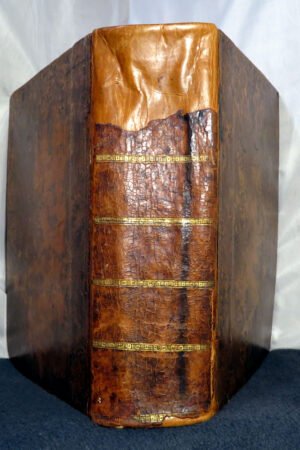
Protected: 1712 Leather Holy Bible Old Testament & New, Book of Common Prayer, & Apocrypha
Original price was: $1,099.99.$900.00Current price is: $900.00. Quick ViewAdd to cart WishlistProtected: 1712 Leather Holy Bible Old Testament & New, Book of Common Prayer, & Apocrypha
Original price was: $1,099.99.$900.00Current price is: $900.00.
Holy King James Bible 1712, printed by Newcomb & Hills, London.
– Red ruled -.Contemporary Spine Restoration.
Believed to have been a Church Bible or a pastor’s Bible.
Approx. 8 inches wide, approx. 10 inches tall, and approx. 3 1/2 inches deep.Contains:
Book of Common Prayer
Psalms
Old Testament
Apocrypha
New Testament
A note found insideCondition:
This Bible is in very good used antique condition. There is some browning of pages, and some wear to the corners. Please see all the photos for condition.
Out of stock
-

1712 The History of the Old and New Testament 4th Impression Nicolas Fontaine
$799.99 Quick ViewAdd to cart Buy Now Wishlist1712 The History of the Old and New Testament 4th Impression Nicolas Fontaine
$799.99
Nicolas Fontaine, The History of the Old and New Testament, ‘Fourth Impression’, London, 1712
A well preserved copy of this scarce work, a wonderful telling of biblical history. A handsome work illustrated with beautiful engravings, many by Richard Blome.Size: Approx. 11 1/2 inches wide by 17 3/4 inches tall by 3 1/2 inches deep.
Weight: Approx. 17 pounds.
Title: The History of the Old and New Testament – ‘Fourth Impression’
Format/binding: Hardback – Leather – Six bands – worn with old repairs.
Book condition: Used Antique – Good
Publisher: Jeremiah Bright, James Brooks, John Stuart, James Holland
Date Published: 1712
Size: Large Folio – over 15″ –See more information below:
1 in stock
-

1770 FOLIO Holy Bible, Old and New Testament, Apocrypha – RARE Date Misprinted
$799.99 Quick ViewAdd to cart Buy Now Wishlist1770 FOLIO Holy Bible, Old and New Testament, Apocrypha – RARE Date Misprinted
$799.99
The Holy Bible, Containing the Old and New Testament, with the Apocrypha; explained with Short, Apt, and Instructive Notes, in a Method entirely different from all Modern Publications of the Sacred Book: and Cleared from that Variety of Opinions and Conjectures, many of which have no Support in the Scriptures; have been collected without Judgement; and serve more to disturb and confound, than to instruct, edify, and confirm the Reader in the Faith and Practice of a Christian.
Dimensions: 11 inches wide and 17 inches tall.
Weight: Approx. 15 pounds.
Title: Holy Bible
Format/binding: Full-Leather – raised band spine
Book condition: Used – Fair
Publisher: Composed by Rev. Bentinck, printed by W. Adlard and J. Browne
Date Published: 1778
Size: FolioSee more information below:
1 in stock
-

1778 Harrison KJ Holy Bible by Reverend Mr. Ostervald Rare Unrecorded Edition
$799.99 Quick ViewAdd to cart Buy Now Wishlist1778 Harrison KJ Holy Bible by Reverend Mr. Ostervald Rare Unrecorded Edition
$799.99
Provenance: Robert and Alice Wilson, of Carlisle, England (19th century family inscriptions to front free endpaper and leather bookplate – Robert & Alice Wilson Manchester).
Dimensions: 11 inches wide and 16 1/2 inches tall.
Weight: Approx. 15 pounds.
Title: Harrison’s Bible
Format/binding: Full-Leather – raised band spine
Book condition: Used – Fair
Publisher: Composed by Rev. Ostervald, printed by and for J. Harrison
Date Published: 1778
Size: FolioSee more information below:
1 in stock
-

1618 Book of Common Prayer, Psalter & Book of Psalms printed by Bonham Norton and John Bill – Rare Early
$629.99 Quick ViewAdd to cart Buy Now Wishlist1618 Book of Common Prayer, Psalter & Book of Psalms printed by Bonham Norton and John Bill – Rare Early
$629.99
1618 Book of Common Prayer, King James Psalter & Book of Psalmes printed by Bonham Norton and John Bill – Rare Early Printing.
Dimensions: Approx. 6 inches x approx. 7 1/4 inches x approx. 2 inches.
Shipping Weight: Approx. 3.2 pounds.
Title: Book of Common Prayer
Contains: Book of Common Prayer, King James Psalter & Book of Psalmes
Format/binding: Hardback-Full Leather 4 Bands
Book condition: Used Antique – Good
Publisher: Bonham Norton and John Bill, Deputies and Assignees of Robert Barker
Date Published: 1618
Size: OctavoSee full description below for more info:
1 in stock
-

1716 NT RED RULED Pocket Bible Edinburgh printed by James Watson RARE
$599.99 Quick ViewAdd to cart Buy Now Wishlist1716 NT RED RULED Pocket Bible Edinburgh printed by James Watson RARE
$599.99
The New Testament of our Lord and Saviour Jesus Christ…, (being the New Testament portion only of 1716 Holy Bible), Edinburgh: printed by James Watson, 1716, letterpress title with woodcut device and decorative border, title and borders red-ruled throughout volume, all edges gilt, contemporary gilt decorated maroon morocco, joints split and some wear, 12mo (12 x 6.2 cm)
1 in stock
-

1790 King James Folio Bible Printed by Executors of B Jackson, Bolton England
$599.99 Quick ViewAdd to cart Buy Now Wishlist1790 King James Folio Bible Printed by Executors of B Jackson, Bolton England
$599.99
This is a 1790 King James “The Christian’s Complete Family Bible” printed by the Executors of B Jackson – Bolton England.
Contains:
Old Testament
Apocrypha
New Testament
Dimensions: Approx. 15 inches in length x 10 inches in width x 3 inches in depth.
Weight: Approx. 10.3 pounds.
Title: King James Bible
Format/binding: Hardback-Leather-Six Raised Bands
Book condition: Used – Good to Fair
Publisher: Printed by Executors of B Jackson
Date Published: 1790
Size: FolioSee more information below:
1 in stock
-

1772 OXFORD Holy Bible OT NT T. Wright and W. Gill, Thick with leather cover
$559.99 Quick ViewAdd to cart Buy Now Wishlist1772 OXFORD Holy Bible OT NT T. Wright and W. Gill, Thick with leather cover
$559.99
THE HOLY BIBLE. Oxford: T. Wright and W. Gill, 1772.
Both titles present, marginal reinforcement of initial blanks and title, lacks at least one leaf in Matthew, tissue repairs to the last page (final page of Revelation), a few leaves with marginal chipping observed, light foxing. Signature of Rebecca Miriam at front, dated 1799, and with further early notes (facing title) stating that Rebecca was the daughter of Ebenezer Meriam (who died 1805 at 81, “Died very suddenly about four o’clock in the afternoon… apparently well a few minutes before he left this world.”) Rebecca died young at age 25, in 1810.
Condition: Sold as-is, inspected at front, beginning of NT, and rear for textual defects (and any defects found are noted).
1 in stock
-

1750 Pocket Bible NT Genesis – Psalms Oxford Printed by Thomas Baskett
$499.99 Quick ViewAdd to cart Buy Now Wishlist1750 Pocket Bible NT Genesis – Psalms Oxford Printed by Thomas Baskett
$499.99
The Holy Bible, containing the Old and New Testaments: Newly Translated out of the original tongues…, Oxford: Printed by Thomas Baskett, Printer to the University, 1750, part work only (Genesis – Psalms), letterpress general title and preliminary leaves, volume text ends at X7 (Psalms CXLVIII. 2), some dust and finger-soiling, Dutch-gilt pastedowns, all edges gilt, contemporary brown crushed morocco with Scottish ‘Herring Bone’ gilt decoration, joints cracked and light wear to extremities, 12mo (12.8 x 6.9 cm)
1 in stock
-

1758 Pocket Bible OT Genesis – Ecclesiastes Edinburgh: Printed Alexander Kincaid
$499.99 Quick ViewAdd to cart Buy Now Wishlist1758 Pocket Bible OT Genesis – Ecclesiastes Edinburgh: Printed Alexander Kincaid
$499.99
The Holy Bible, containing the Old and New Testaments: Newly Translated out of the original tongues…, Edinburgh: Printed by Alexander Kincaid, 1758, part work only (Genesis – Ecclesiastes), letterpress general title and preliminary leaves, volume text ends at 2F9 (Ecclesiastes xxxi. 31), some dust and finger-soiling, scattered spotting, floral blocked endpapers (slightly worn) with 18th and early 19th-century manuscript ownership and genealogical entries to blanks and verso of free endpapers (names include Margaret Dickie with various dates 1771 to 1805, Margaret Dunlop 1788, James Dunlop 1826, William Dunlop born 25 Nov 1793 etc.), all edges gilt, contemporary maroon brown crushed morocco with elaborate Scottish ‘Wheel’ gilt decoration, joints cracked and some wear at head, 12mo in 6s (13.1 x 7.4 cm)
1 in stock
-

1735 Red Ruled KJ Bible OT Genesis – Esther John Baskett London Octavo
$499.99 Quick ViewAdd to cart Buy Now Wishlist1735 Red Ruled KJ Bible OT Genesis – Esther John Baskett London Octavo
$499.99
1735 Red Ruled KJ Bible OT Gen – Esther , John Baskett London
A scarce 1735 Bible printed by John Baskett in London.
Size: Approx. 6 3/8 inches tall, approx. 4 inches wide, and approx. 1 inch deep.
In good condition. Spine restored, leather boards corners scuffed and leather worn. Binding tight, text clear and readable. Please see all photos for condition.
1 in stock
-
New Item !

The Authorised Version of the English Bible, 1611, Edited by William Aldis Wright 1909
$399.99 Quick ViewAdd to cart Buy Now WishlistThe Authorised Version of the English Bible, 1611, Edited by William Aldis Wright 1909
$399.99
This is more than just a set of Bibles; it is a tangible link to a pivotal moment in literary and religious history, curated by one of Cambridge’s most esteemed scholars and owned by a New England historian. We present for acquisition a rare, complete five-volume set of The Authorised Version of the English Bible, 1611, Edited by William Aldis Wright.
See more information below:
1 in stock
-

1765 1st Edition The Lives of John Wicliff ( Wycliffe ) by William Gilpin
$399.99 Quick ViewAdd to cart Buy Now Wishlist1765 1st Edition The Lives of John Wicliff ( Wycliffe ) by William Gilpin
$399.99
The Lives of John Wicliff, and of the Most Eminent of His Disciples;
Lord Cobham, John Huss, Jerome of Prague, and Zisca
By William GilpinWilliam Gilpin was an 18th-century English artist, who, early in his career, published a biographical account of the important Protestant church fathers including John Wycliffe, Jan Huss, Jerome of Prague, and Jan Zizka.
See more information below:
-

1752 Burkitt Expository Notes with Practical Observations, New Testament of our Lord and Saviour JESUS CHRIST
$399.99 Quick ViewAdd to cart Buy Now Wishlist1752 Burkitt Expository Notes with Practical Observations, New Testament of our Lord and Saviour JESUS CHRIST
$399.99
Adorned with 78 copper plates (one fold out plate), together with a map of all the places mentioned in the New Testament by Richard William Seale. Map still attached to last page. Curiously the title plate for Burkitt has been pasted over with what looks like a newer one.
There is age toning and page wear with some staining as would be expected. Most text and engravings crisp & clear. Margins good. Both boards detached and leather worn, Spine intact, tight. Please see all photos for condition.
Dimensions: Approx. 14 3/4 inches in length x 9 1/2 inches in width x 2 3/4 inches in depth.
Shipping Weight: Approx. 10.8 pounds.
Title: Expository Notes / New Testament
Format/binding: Hardback-Full Leather
Book condition: Used – Fair/Good
Publisher: William Burkitt
Date Published: 1752
Size: FolioMore information in Description below:
-

1696 Explicatory Catechism: An Explanation of Assemblies Westminster Shorter Catechism Vincent, Thomas
$375.00 Quick ViewAdd to cart Buy Now Wishlist1696 Explicatory Catechism: An Explanation of Assemblies Westminster Shorter Catechism Vincent, Thomas
$375.00
Title: An Explicatory Catechism: Or, An Explanation…
Publisher: Printed for Thomas Parkhurst, London
Publication Date: 1696
Binding: Hardcover
Book Condition: FairSee more information below:
1 in stock
-

1726 BOOK OF COMMON PRAYER TOGETHER WITH PSALTER OF PSALMS OF DAVID
$349.99 Quick ViewAdd to cart Buy Now Wishlist1726 BOOK OF COMMON PRAYER TOGETHER WITH PSALTER OF PSALMS OF DAVID
$349.99
Printed by John Baskett and by the assigns of of Henry Hills deceas’d. Leather binding with gilt decoration. Gilt edges. Marbled endpapers. Many engravings. Bound with a New Edition of the Psalms of David fitted to the Tunes used in Churches by N Brady and printed by W Brady for the Company of Stationers in 1727.
The Prayer Book is unpaginated. The Psalms of David has 192 pages.
Condition: please see images. In Good condition. Clear text and Illustrations. Gilt edges a little faded.
1 in stock




